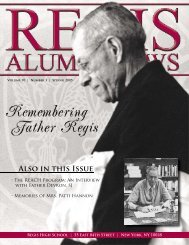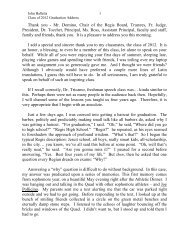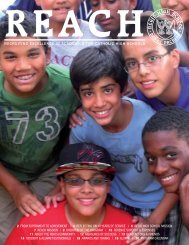RAN - Summer 2005 08.indd - Regis High School
RAN - Summer 2005 08.indd - Regis High School
RAN - Summer 2005 08.indd - Regis High School
- No tags were found...
You also want an ePaper? Increase the reach of your titles
YUMPU automatically turns print PDFs into web optimized ePapers that Google loves.
<strong>Summer</strong> <strong>2005</strong> 11<br />
“A Margin of Luck”<br />
By: Greg Vadasdi ‘94<br />
November of 2004 I stood at the top of<br />
In Mt. Ama Dablam (22,494 feet) in the<br />
Nepal Himalaya and looked across the valley<br />
at Mt. Everest (29,028 feet). Hundred mileper-hour<br />
jet winds had scoured the snow<br />
form the upper mountain and the rocky,<br />
dark summit pyramid looked sinister. It was<br />
a breath taking view and at that moment<br />
all my hesitation vanished. I would return to<br />
attempt Everest, despite its regularly tragic<br />
history.<br />
In the summer of 2004 I wrote down an<br />
ambitious list of objectives for my year away<br />
from the corporate world. The list included<br />
some work related items, but in reality it<br />
centered on endurance events around the<br />
globe such as triathlons and mountaineering.<br />
The plan, on paper at least, was to climax<br />
the year with an attempt on Everest. After<br />
leading a successful expedition to Mt.<br />
McKinley (20,320 feet) in May 2004, I felt<br />
that I could mount a credible effort with ten<br />
months to train, prepare and gain additional<br />
experience. I shared my plan with some close<br />
friends and their response was muted; they<br />
thought I was mad. Privately, I was also<br />
apprehensive regarding the dangers and<br />
difficulties of the path I chose.<br />
My confidence increased as I completed<br />
milestones such as Ama Dablam, the aptly<br />
named Epic Camp Australia (a triathlon<br />
training camp), and the Ironman Canada<br />
and New Zealand triathlons. In a sense I had<br />
trained for Everest ever since I started hiking<br />
with my parents at age five and rock climbing<br />
at age thirteen. The idea of attempting<br />
Everest gradually changed from a far fetched<br />
dream into a reasonable proposition. I knew<br />
I needed a strong partner to have a chance<br />
to summit, and sharing the adventure with a<br />
friend would make it much more enjoyable.<br />
Daniel Protz was my college crew teammate,<br />
a world champion rower, investment<br />
colleague, and regular climbing partner. He<br />
was the ideal mate for the ten week journey<br />
and not just because he was my only friend<br />
with the inclination, time and resources to<br />
commit to the venture. We had climbed<br />
Mt. Elbrus (18,510 feet) and Mt. McKinley<br />
together, and we were equally stubborn and<br />
aggressive. Most importantly, we were both<br />
fully committed, willing to do and endure<br />
anything required for success, while climbing<br />
safely. We share a passion for tackling athletic<br />
challenges, and in March we completed the<br />
New Zealand Ironman triathlon and climbed<br />
in the Southern Alps. These were our final<br />
mental and physical preparations for our<br />
Everest expedition. It is critical to have a<br />
compatible team as nothing torpedoes an<br />
expedition faster than personality conflicts.<br />
In January of <strong>2005</strong> we wired the deposit to<br />
Asian Trekking and ordered oxygen bottles<br />
from Russia. Asian Trekking was our Nepal<br />
based expedition support agent. With their<br />
help we acquired government permits,<br />
purchased food, and hired two cooks and<br />
two high altitude climbing Sherpas. The<br />
staff, equipment and support provided<br />
were excellent and essential to our success.<br />
Despite the hardships of living in Tibet and<br />
Nepal, the Sherpas have a positive attitude,<br />
are sharp and possess an immense work<br />
ethic. We called ourselves The Big Green<br />
Everest Expedition after the mascot of our<br />
alma mater, Dartmouth College.<br />
Climbing Everest was an unforgettable<br />
athletic, spiritual, cultural and learning<br />
experience. It was a much broader adventure<br />
than I expected. On June second, after a ten<br />
hour climb from high camp, I stood on the<br />
summit with Dan and our two indefatigable<br />
Sherpas, Ang Mingma and Mingma Dorjee.<br />
I felt joy and satisfaction, but these were<br />
tempered by my fatigue, cold feet and<br />
awareness of the precarious nature of our<br />
position. At the summit the oxygen in the air<br />
was a third of that at sea level, and we had a<br />
long, complicated descent ahead of us.<br />
Climbing at extreme high altitudes, even<br />
with the aid of supplementary oxygen, is<br />
demanding and the margin for error is razor<br />
thin. A climber can feel strong one minute<br />
and suddenly, fall apart the next, struggling to<br />
survive. The four bodies we passed on summit<br />
day were a grim reminder of this. One was<br />
of a Slovenian climber who had run out of<br />
oxygen on his return from the summit. He sat<br />
down, too exhausted to continue and died.<br />
When we passed by two weeks later, he was<br />
still attached to the fixed rope on the summit<br />
pyramid, his anguished face and clawed<br />
fingers were a terrible sight. Thankfully, we<br />
had strength and good health, spare oxygen<br />
bottles in our backpacks, and great support<br />
from our Sherpas. Nevertheless, I have never<br />
felt as tired in my life as I did on summit day,<br />
especially in the last hours of the down climb<br />
to high camp.<br />
While we had been remarkably healthy<br />
throughout the expedition, Everest would<br />
not let us part unscathed. On summit day<br />
I suffered minor frostbite to my toes. Dan<br />
developed a serious chest infection a few<br />
hours after we dragged ourselves into<br />
advanced base camp, shattered from our<br />
summit push. His lungs filled with fluid,<br />
nearly drowning him. I scrambled through<br />
the cold night to find a doctor. At 2 am Dan<br />
received an IV of antibiotics and oxygen. He<br />
was weak, but able to hike to base camp the<br />
next day.<br />
We were lucky on our climb of Everest. Any<br />
number of variables such as high winds,<br />
a faulty oxygen regulator, or a slip at an<br />
inopportune moment could have derailed<br />
our summit bid or worse. I shudder to<br />
think of what could have happened if Dan’s<br />
debilitating infection had struck a day or<br />
even a few hours earlier. There is virtually no<br />
chance of rescue from high on the mountain.<br />
Our margin of luck was just enough for us to<br />
summit and return safely.<br />
I hope the following photo-essay gives a<br />
feel for our experiences. You can find more<br />
photos and information about the expedition<br />
at www.biggreeneverest.com. The website<br />
will soon incorporate our foundation to aid<br />
Sherpa education. Tourism to the Himalaya<br />
brings money and awareness of the region.<br />
<strong>High</strong> altitude climbing Sherpas, who would<br />
otherwise be sustenance farmers, can make<br />
a better living by working on expeditions.<br />
However, many Sherpas would prefer<br />
their children didn’t have to work in such<br />
a hazardous occupation. The foundation<br />
will provide aid for the higher education of<br />
Sherpa children.<br />
PHOTO ESSAY
















